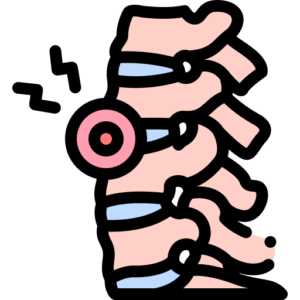SPINE BONE & SPINAL TUMOR TREATMENT

Spine and spinal cord tumors that develop and spread in the spine can occur in two different forms: those that directly develop in the area and those that spread from another location to the spinal cord. These tumors cause serious symptoms in patients, leading to motor skill abnormalities. Patients may experience partial paralysis, lumbar hernia, difficulty in urinating, weakness in the legs or difficulty in bowel movements. These tumors can be benign or malignant and can be treated with surgical methods that involve endoscopic procedures of removing them from the affected area. After surgery, patients are regularly monitored to prevent the tumors from recurring.
What are Spine and Spinal Cord Tumors?
The structure of the spine consists of bones, nerves and a spongy structure that contains jelly-like material. The spine should be both strong and flexible. This allows for movement and the transfer of nerve signals from all parts of the body to the brain via the spinal cord. Spine and spinal cord tumors are the uncontrolled growth of cells that develop and are located in that area. Tumors can be divided into two categories: primary and secondary. Some cases have tumors that directly develop in the spine, these are primary tumors. Secondary or metastatic tumors are cases where cancer cells from other organs spread and settle in the spine.
Diagnosis of spine and spinal cord tumors
The patient’s complaints and history are taken and a physical examination is performed. The spinal structure is carefully scanned with computed tomography (CT) and magnetic resonance imaging (MRI). Other imaging tests are also used for detailed examinations. If a tumor is detected, a biopsy is performed on the tumor in that area under local anesthesia to learn the development and type of the tumor and the diagnosis is made.
How do Spine and Spinal Cord Tumors Form?
The formation of spine and spinal cord tumors is generally unknown. Based on pathological findings, secondary tumors are more commonly observed than primary tumors that develop directly in the area. The causes of formation include lung and breast cancer frequently. In these cases, cancer cells settle in the spine and form tumors.
Symptoms of Spine and Spinal Cord Tumors
Symptoms often include:
- Severe weakness in the legs, which may be accompanied by partial paralysis.
- Difficulty in urinating and bowel movements, which may resemble lumbar hernia symptoms.
- A gradual, worsening pain in the lower back.
- In cases of tumors that have spread to the spine (metastatic tumors), patients may also experience nausea, vomiting, and lack of appetite due to the primary cancer.
- In children, symptoms such as falling, loss of balance, and difficulty walking may be significant indicators.
- Tingling or numbness in the hands may also be present.
What Methods are Used in the Treatment of Spine and Spinal Cord Tumors?
In the treatment, surgical methods, chemotherapy, and radiotherapy are primarily used, similar to other cancer treatments. The treatment to be applied is carefully planned by taking into account the patient’s tumor growth history and spread rate. Sometimes the tumors can be present for more than 5 years in a sneaky way. Sometimes, chemotherapies are applied first before surgical methods for some patients. Especially, when the patient’s spinal structure is damaged due to the tumor, fractures can be observed. In such cases, a much more careful process should be followed, and the first priority is to strengthen the patient’s spine. In order to achieve this, a platinum screw selected according to the area is fixed.
Different surgical procedures are available depending on the growth of the tumors. It is not possible to completely remove the tumors during surgery in tumors that occur as metastasis in spinal and spinal cord tumors. The tumors are partially removed, and the patient’s functional ability is restored. In primary tumors that occur in the spine, surgical procedures are applied taking into account the location of the tumors. It is much riskier to remove tumors in the coccyx area or neck area. Especially respiratory problems may occur when the tumor in the neck is removed. Therefore, in the surgery of spinal and spinal cord tumors, the aim is not to remove the whole tumor. Tumors are removed in a way that will regain the patient’s functional ability. More radiotherapy and chemotherapy methods are followed in the treatment process. This situation is much less risky for the patient. After the surgery, the patient should be under regular doctor control.
Why Choose Us?
At Dr Özgür Akşan – Health Türkiye, we have been providing top-quality neurosurgical treatment options for almost a decade under the guidance and leadership of Op. Dr. Özgür Akşan. Our team is comprised of highly experienced and skilled surgeons, including Dr. Özgür Akşan, Dr. Nail Özdemir, and Dr. Feryal Akşan, all of them having more than 20 years of experience in medicine.
We offer a wide range of treatment options for various neurosurgical conditions, including herniated discs, lumbar spinal stenosis, traumatic brain injury, brain tumors, cervical disc herniation, Chiari malformation, carpal tunnel syndrome, and more. Our team is highly skilled in performing advanced neurosurgical procedures, such as microsurgical discectomy, endoscopic discectomy, spinal fusion instrumentation, craniotomy, craniectomy, gamma-knife radiation therapy, and many more.
At Dr Özgür Akşan – Health Türkiye, we are committed to providing personalized care and tailored treatment plans for each patient based on their unique needs and medical history. Our clinic in Izmir is equipped with the latest technology and we are working with private hospitals with state-of-the-art facilities to ensure the highest level of care for our patients.
Choose Dr Özgür Akşan – Health Türkiye for your neurosurgical needs and experience the expertise and care of our highly trained team of neurosurgeons, led by Dr. Özgür Akşan himself.
